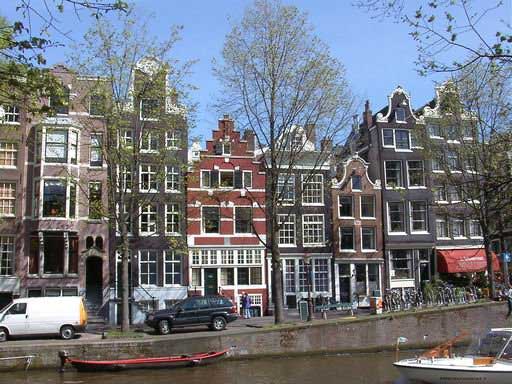|
|||
|
Philatelia.Net / Beer / Plots / The directory «Plots»AmsterdamAmsterdam, the greatest planned city of northern Europe, has always been a well-known name in world history. In the 17th century Amsterdam was the centre of world economy, and nowadays the city is known for its tolerant character. Amsterdam was founded as a fishing village around the thirteenth century. Amsterdam developed round a dam in the Amstel river at the end of the 12th century. The name Amstelledamme occurs for the first time in the toll concession of Floris V, Count of Holland, dated October 27, 1275. During the 14th, but especially the 15th century, Amsterdam underwent a rapid development, which laid the foundation for the Golden Age. Only very few medieval buildings survive today. Some examples: the Old and New Churches and the Houten Huis (Wooden House) at the Begijnhof. Throughout the Middle Ages houses were generally built of wood, a vulnerable type of construction material. The famous Houten Huis is no exception to this rule. Consequently, most of them were destroyed. Nevertheless, a surprisingly large number of Amsterdam dwellings still have timber frames. Amsterdam offers a limitless supply of restaurants, cafes and bars, somewhere around 1500! The words, bar and cafe are usually used interchangeably. The distinction is mostly seen in the title or layout of a place. Every street side, corner, canal, nook and cranny has something to offer your taste buds and mood. The spectrum begins with the traditional and relaxed brown cafes and ranges to the lively and crowded bars. The Dutch word that embodies the unique experience of coziness, or a comfortable, relaxing time, is 'Gezelligheid'. It is this concept that each cafe or bar tries to express in its own customized way. While some cater to the artist’s soul with live music or exhibitions, others appeal to the romantic with lovely views and special decor. Still others satisfy the needs of the sportive drinkers, with a wide selection of beers, bar games and ‘borrel hapjes’ (snacks). With going out for a coffee, beer or Dutch gin being an almost daily routine, the locals keep the example of how to enjoy the city alive. Ajman, 1971, Montelbaanstoren Tower Czechoslovakia, 1965, Amsterdam, Horse Jumping Czechoslovakia, 1967, Amsterdam's House Gambia, 2001, View on New Cherch and Town Hall in Amsterdam Gambia, 2002, Amsterdam House Ghana, 2003, Popeye the Sailorman tours Amsterdam Ghana, 2003, Popeye the Sailorman tours Amsterdam Grenada, 2001, The Raampoortje Gate at Amsterdam Guinea, 2007, Elisabeth Robinson, Amsterdam Israel, 1970, Portuguese Sinagogue Israel, 1988, House of Anne Frank Liberia, 1996, Amsterdam, 1928 Marshall Islands, 2002, «Spyker» (1907) in Amsterdam Netherlands, 1948, Palace on the Dam Netherlands, 1948, Nieuwe Kerk Netherlands, 1955, Bourse Netherlands, 1968, Magere Bridge Netherlands, 1969, Open-air school (1930) Netherlands, 1969, Orhanage Netherlands, 1975, Amsterdam Netherlands, 1975, Portuguese Sinagogue Netherlands, 1975, Amsterdam Netherlands, 1975, Begjinhof Netherlands, 1979, Porch of Old Amsterdam Theatre Netherlands, 1980, Nieuwe Kerk and queen Beatrix Netherlands, 1981, Nieuwe Kerk and queen Beatrix Netherlands, 1982, Agnieten Chapel and Banners Netherlands, 1982, Royal Palace Netherlands, 1982, Royal Palace and Dam Netherlands, 1985, Rijksmuseum Netherlands, 1988, Violin and Concertgebow concert hall Netherlands, 2005, Monument on Dam place Netherlands, 2011, Noord-Zuid-Holands Coffee House Netherlands, 2012, Rembrandt House Poland, 2008, Rijksmuseum St. Vincent, 2001, Raampoortje, Amsterdam (Wouter van Troostwijk) YAR, 1970, Amsterdam's House Netherlands, 1982.01.14, Netherlands, 1982.10.05, Advertising: |
|||
© 2003-2025 Dmitry Karasyuk. Idea, preparation, drawing up
|

